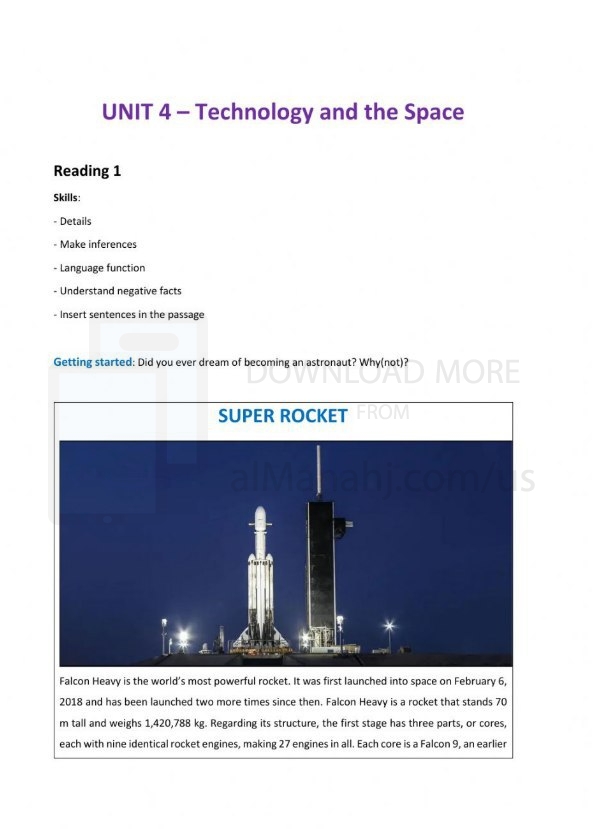| You are here: Almanahj Website ⇒ American curriculum ⇒ 7th Grade ⇒ Information and comm ⇒ Term 1 | ||
|---|---|---|
Worksheet about Technology and the space | ||
|---|---|---|
| Subject: Information and comm | ||
| 7th Grade | ||
| Term 1 | ||
| Year: 2023/2024 | ||
| Size: 532.1KB | ||
| Number of clicks: 67 | ||
| Publish date:November 15, 2023 | ||
| Added by: Eman | ||
| Last download date: 2024-08-30 02:04:26 | ||
| Updated by: Eman9966 on 2023-11-15 17:36:59 | By: theodor Nelson Olarte | |
| File info: Technology has played a crucial role in enabling human exploration and understanding of space. From the launch of the first artificial satellite, Sputnik, in 1957, to the ongoing missions to Mars and beyond, technology has been essential in overcoming the challenges of space travel and unlocking the mysteries of the universe. Key Applications of Technology in Space Exploration: Launch Vehicles: Rockets and other launch vehicles provide the necessary propulsion to overcome Earth's gravity and send spacecraft into space. Spacecraft Design and Construction: Advanced engineering and materials science enable the development of spacecraft that can withstand the harsh environment of space and perform their missions effectively. Navigation and Communication Systems: Satellite navigation systems like GPS and spacecraft communication systems allow for precise positioning and data transmission between space and Earth. Remote Sensing and Imaging: Satellites equipped with cameras and other sensors provide valuable data about Earth's environment, weather patterns, and natural resources. Robotics and Automation: Robotic probes and autonomous vehicles are used to explore planetary surfaces, conduct experiments, and collect samples. Life Support Systems: Astronauts rely on advanced life support systems to provide breathable air, water, and waste management in the confined environment of space. Examples of Technology-Driven Space Missions: Voyager 1 and 2: These probes have traveled billions of kilometers through interstellar space, providing unprecedented views of the outer planets and sending back groundbreaking data about the solar system. Hubble Space Telescope: This orbiting telescope has revolutionized our understanding of the universe, capturing stunning images of galaxies, nebulae, and distant stars. International Space Station (ISS): This collaborative project has enabled continuous human presence in space, conducting scientific research and laying the groundwork for future space exploration. Mars Rovers: Robotic rovers like Curiosity and Perseverance have explored the Martian surface, searching for signs of past or present life and analyzing the planet's geology. James Webb Space Telescope (JWST): This powerful telescope is designed to peer into the early universe, observing the formation of the first stars and galaxies. Future Directions of Technology in Space: Reusable Spacecraft: Reusable launch vehicles and spacecraft could significantly reduce the cost of space travel and enable more frequent missions. Interstellar Travel: Breakthroughs in propulsion technology could make interstellar travel a possibility, enabling humans to reach other star systems. Space-Based Solar Power: Technology could be developed to harness solar energy in space and transmit it back to Earth, providing a clean and sustainable energy source. Space Mining: Advanced robotics and resource extraction technologies could enable the mining of asteroids and other celestial bodies for valuable resources. Space Tourism: Technology could make space travel more accessible and affordable, opening up opportunities for commercial space tourism and exploration. As technology continues to advance, the possibilities for space exploration are limitless. With innovation and ingenuity, we can unlock the secrets of the universe, expand our understanding of our place in it, and even venture beyond our solar system in search of new worlds and life. | ||
| Downloading link Worksheet about Technology and the space |
|---|
|
1700033950.pdf
The file is being prepared for download
|
| File images |
|---|
 |